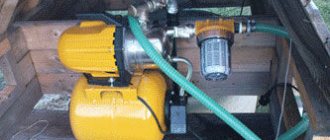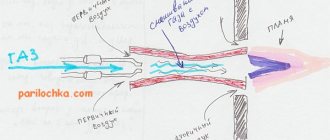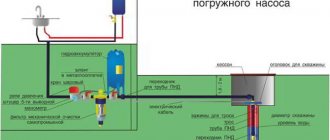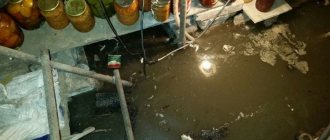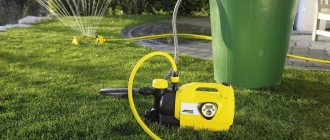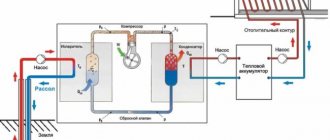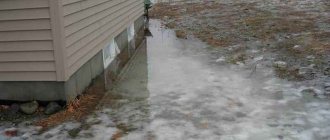Remember how much time, effort, and sometimes nerves it takes to simply provide water to a country property. Try to transfer a considerable volume manually to the water collection points without getting tired. And if you still need to fill the containers for watering the garden, the swimming pool and the tanks in the bathhouse, then it is easier to abandon the idea altogether than to implement it. Is it true?
It’s a completely different matter if such a labor-intensive process is carried out by pumping equipment instead of you. Tireless “workers” will provide all facilities with water as quickly as possible. Therefore, a pumping station for your home or beloved dacha is simply necessary. And we will tell you in detail how to choose it in the next article.
The information we offer illuminates in great detail the nuances of the device and the principle of operation of the system. The criteria for choosing a unit and the most popular models are presented to your attention. The information we offer is supported by useful diagrams, photos and videos.
Selecting a model based on specific characteristics
The variety of models on the market is explained by the fact that the conditions for connection can be completely different: some need a pumping station option for a well (with a surface pump installed in a caisson), others need a submersible mechanism or a more powerful model with an ejector capable of pumping water from a well with depth 20-25 m.
When choosing pumping equipment in a store, the properties of the samples provided must be compared with individual requirements.
Calculation of pump performance
There are difficulties with calculating productivity, because many people do not know what to start from. In fact, for objective calculations, several factors should be considered.
For example, it is important to take into account the volume of drawdown of a well - a one-time water intake at zero flow rate, the rate of restoration of the volume of liquid in the source, the mode of active operation of the water supply system, etc.
To find out the average, data for 1 day is enough. This is possible due to the complete restoration of the volume of water in the well in 5-6 hours (the time when the liquid is not consumed at all).
The busiest “rush hours” are periods of time when there is active use of bathrooms or watering of a personal plot. They are the ones most suitable for the objectivity of calculations.
To calculate, you need to add up the parameters of all consumption points, not forgetting the correction factor, and derive the unit of productivity - l/min or l/hour
Let's assume that the well has a flow rate of 200 l, and the drawdown volume is 50 l. If three family members take a bath (200 l each) sequentially, and we need water to flow freely to other water collection points, the productivity should not be lower than 300 l/h.
Sometimes the calculation is made based on the sum of water consumption by all family members or by calculating the maximum water use - peak consumption.
It is assumed that all water points are used simultaneously, the average flow of which is:
- washbasin mixer – 0.1 l/s;
- kitchen mixer – 0.15 m/s;
- drain tank - 0.1 m/s;
- shower – 0.25 l/s;
- washing machine – 0.3 l/s.
The maximum possible productivity is considered to be 800-1000 l/h (or more), but not every well has such a water supply and high recovery rate.
Maximum water intake depth
To find out this parameter, you need to know exactly the dimensions of the well (well) and measure the distance from the installation site of the accumulator to the source.
The basic value is taken to be the height from the water surface to the axis of the pump installed near the well or well. If the station is located at any distance, for example, in the basement of a house, then the horizontal section must also be taken into account.
When making calculations, you should rely on the value of not the static, but the dynamic level - the average value for regular fluid intake for 1-2 days
There is an allowance for error due to the resistance exerted by pipes, check valves and filters. This means that you need to add about 15% more to the amount received.
By the way, the resistance of stainless steel pipes, which is used less and less, is much higher than that of plastic communications.
The vertical arrangement of pipes relates to the horizontal in a ratio of 1:10. For example, the distance to the installation site of the hydraulic accumulator is 20 m, the depth of the well to the water surface is 8 m, therefore, equipment with a minimum intake depth of 8 m + 20 m is needed: 10 = 10 m
Hydraulic accumulator tank volume
When choosing a pumping station for a private home, do not forget to inquire about the volume of the hydraulic accumulator, since the full supply of water depends on the size of the tank. The larger the tank, the more space the equipment takes up and the more expensive the entire installation costs.
It is believed that large tanks have less frequent on/off cycles, which increases their service life significantly.
Gilex Jumbo pumping station with built-in ejector and automatic control: power – 1100 W, hydraulic accumulator capacity – 24 l. Suitable for use in wells and wells
For a single resident or a couple, a volume of 24-30 liters is sufficient. A small container is also appropriate when the need for water supply occurs periodically, for example, on weekends.
A volume of 50 liters is an average capacity, suitable for serving a group or family of 3-5 people permanently living in a country house. For housing that unites more than five people under its roof, you should purchase equipment with a 100-liter tank.
It is irrational to buy containers smaller than 24 liters, as they wear out quickly and, accordingly, have a short service life.
Water pressure in the system
The functioning of the system will be complete and comfortable only if there is sufficient water pressure at each point of water consumption. This means that the pressure in the network ensures an uninterrupted, correct supply.
For example, for a kitchen faucet, a pressure of 1/1.5 atmospheres is sufficient, which equals 10/15 m of water column. More serious equipment requires increased parameters.
Pumping station Grundfos JPBasic2 PT with a power of 600 W and a maximum head of 42 m. Purpose - increasing pressure in household systems, watering summer cottages or gardens
The water pressure value can be found in the instructions. Units with a maximum head of 45-50 m can be used equally well both in country cottages and in small businesses.
They have increased productivity (up to 4500 l/h) and are often equipped with an additional storage tank
Power and voltage
The installation power and supply voltage are necessary for the correct connection of the pumping station. The standard power supply voltage - 220 V - is typical for most household pumping stations, since single-phase AC networks are much more common.
A voltage of 380 V is necessary for high-performance operation of equipment on an industrial scale, and in the residential sector it can only be found in multi-story buildings.
The Parma CH-600P model is equipped with a self-priming pump and is used to supply water to a house or garden from a tank, pool or well. AC voltage – 220 V, power – 600 W
The power of household installations with a hydraulic accumulator is from 600 to 2000 W. It influences the choice of protective devices and power cable. If overheating, short circuit, or dry running occurs, modern models automatically turn off.
Unit type and functionality
Models from the same manufacturer, and even more so from different brands, differ in appearance and potential capabilities.
Suppose a pressure switch, which ensures timely shutdown of equipment, can be connected in two ways: using a flexible hose or directly to the housing. This does not change the principle of operation, only the external design is different.
More serious differences relate to the type of pump - the main working part. The most common are self-priming devices, which easily tolerate light contamination of water and the presence of air in the pipes.
The main disadvantage of units of this type is the limited height of liquid lifting from the source (from 6 to 9 m). Another small drawback is the high noise level, but this can be solved by installing the pump in a separate room.
Some models are equipped with an ejector, built-in or external. The built-in one allows you to increase the depth of water supply to 15 m, while the external one is capable of extracting liquid from a depth of 45-50 m. The disadvantage is reduced efficiency and noise.
The ejector provides recirculating (loop) movement of water thanks to a special design - an additional hose immersed in water with a special nozzle
For wells and boreholes up to 10 m deep, quieter multi-stage devices are used. They are more expensive and more complex in design, have powerful pressure and a high degree of productivity. The main external difference between units of this type is the elongated shape of the working chamber, which accommodates several wheels instead of one.
For summer cottages with a small house and a shallow well (6-7 m), vortex pumping stations are suitable. They are characterized by high pressure (which allows them to be used to increase pressure in the system), quiet operation, efficiency, but low productivity
Reputation of the equipment manufacturer
When choosing this or that model, you definitely pay attention to the manufacturer and try to remember how reliable its products are. This is the right approach, because the life of a pumping station is measured in years, and there is no point in purchasing a low-quality one.
Nowadays, almost all companies involved in the production of pumping equipment are focused on the interests of the consumer and have in their arsenal a whole set of models that differ in technical characteristics.
Well-known domestic brands Gilex, Zubr, Vikhr compete with the Italians Marina, Ergus, Pedrollo in terms of the number of lines presented.
However, the palm belongs to the German brands Gardena, Metabo, Wilo SE, Kärcher, Grundfos, which have always been distinguished by excellent quality and maximum functionality.
All brands that have taken root in Russia have adapted their equipment to local climatic conditions. Let's consider the rating of popular models so that the idea of pumping devices becomes more complete.
Features of pumping equipment
Pumping stations have standard equipment. The unit consists of the following parts:
1.hydraulic accumulator, which is the main part of the device. Protects against water hammer when liquid is supplied to the tank.
2. surface pumping equipment, with the help of which water is drawn from the source.
3.an electric motor in which an electrical wire is connected to a mechanism to control the pressure.
4.monometer, which controls the pressure in the station.
5. relay that controls the pressure level. The device automatically adjusts, starts working on its own, if the pressure drops, and when it reaches the maximum, it turns off itself.
Useful tips
When designing a house for a well, the dimensions of the future structure need to be correlated with your own dimensions, so that it is convenient for you to get water with a bucket or get inside for cleaning, repairing or inspecting equipment. In the case of a well, it is more convenient to make the door not in the roof, but in the wall of the house, if it is not a concrete ring.
For the installation of any structure it is necessary to make a foundation. For wooden houses, it is enough to place posts in the corners. When making frame buildings, vertical corner posts are lowered into holes and filled with concrete or secured with corners and anchors to the concrete base. And if the house above the well is made of stone or brick, a strip foundation or slab is poured under it.
After cutting and fitting, all wooden elements must be treated with protective impregnations, and the finished structure is coated with varnish or paint.
Original house made of wood and stone Source na-dache.pro
In order not to constantly climb inside the house to open the tap or turn on the pump, it is better to immediately take the water supply controls outside.
Correct installation of the station
How to install a pumping station in a private house? Further work without vibration and unnecessary noise depends on correct installation.
The installation is delivered to the market ready for connection. All systems are debugged. It remains to determine the installation location and equip it. A monolithic foundation is being created for the station. Communications are brought to the connection point. It is necessary to install a check valve at the pump suction so that the system is flooded. A filter is installed on the pipe to prevent pebbles from entering the impeller. The equipment must be installed using anchor bolts using vibration dampers.
The assembled installation is grounded. The suction pipeline is filled with water through a funnel. After turning on the station, check the tightness of all connections. It is better to install the system with the assistance of an experienced specialist. It is necessary to provide space heating in winter. If the equipment is installed in a pit or caisson, the temperature there will not drop below 0 degrees, but the lid should be insulated from above.
Material of manufacture of the pump and its structural elements
The main disadvantage of centrifugal pumps is their high demands on the purity of the pumped water. Grains of sand, silt and other solid particles that get inside cause premature wear of pump parts.
The service life of the equipment largely depends on the material from which the impeller is made. Stainless steel impellers are more durable, but are more expensive than plastic products, often installed in household models.
Various materials are also used to make the pump housing.
1. Pumps in plastic cases are the cheapest and, importantly, the quietest. However, such pumps are not reliable.
2. Steel, on the contrary, is the most expensive and noisy, but at the same time the most durable.
3. Cast iron ones occupy an intermediate position in all respects.
In addition to the material used to make the pump housing and its impeller, when selecting, you should pay attention to one more parameter, namely the material of the electric motor winding. Often, aluminum winding is used to reduce the cost and lighten the design.
Unfortunately, it is less durable than copper, which negatively affects the overall reliability of the pump, which is forced to work year-round and almost around the clock.
Briefly about the main thing
Every owner must first of all ensure that fresh, clean and safe water flows uninterruptedly into the house from the well. And for this, the source must be protected from dirt getting into it and from freezing of water in the pipes. Both problems can be solved by installing a protective shelter in the form of a house over it, and you will receive an additional bonus - an interesting landscape design object. You can buy a house ready-made or make it yourself from wood, brick and other materials left over from construction.
Ratings 0
How to choose the right water units?
How to choose a pumping station and take into account all the necessary nuances? With a wide variety of models that manufacturers offer us, it will be difficult for the average consumer to make a choice in favor of one model or another. We give some recommendations on how to choose a water station.
Try to research the manufacturer. How reliable is it? Do you have a service and repair center in your city or region? What is the warranty period? What are the manufacturer’s requirements for warranty service to be maintained?
What materials are used to produce the pump, accumulator tank, impeller? What is the tank volume? What is the pump's capacity? What is the maximum and minimum suction lift of the pump? Station power. What is included in the pump station kit?
Technical indicators
If you plan to install a pumping station for a dacha or household, when choosing it, pay special attention to performance. The best solution would be a design that will provide the required pressure from the well, capable of satisfying the need for water for domestic needs and for a personal plot.
For a comfortable stay outside the city for a family of 4 people, installing a water station of medium or low power is suitable. Typically, such designs are equipped with a hydraulic tank designed for 20 liters. They lift liquid from the well in a volume of 2 - 4 cubic meters per hour and create a pressure of 45 meters or more.
In addition, before installing a pumping station, when purchasing, take into account its dimensions, the water level when the pump is off and running, the type of filter and the cross-section of the pipes.
